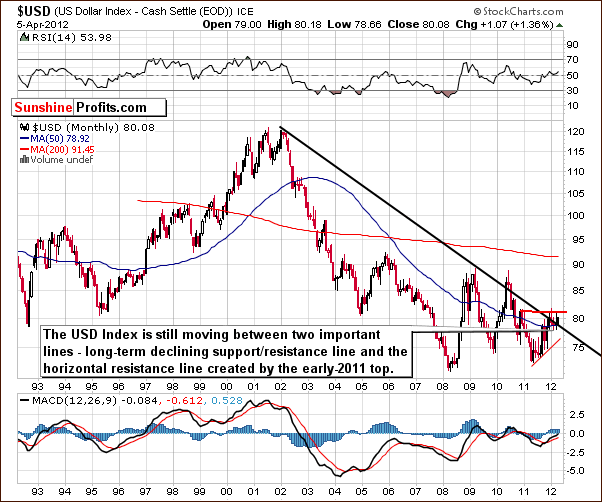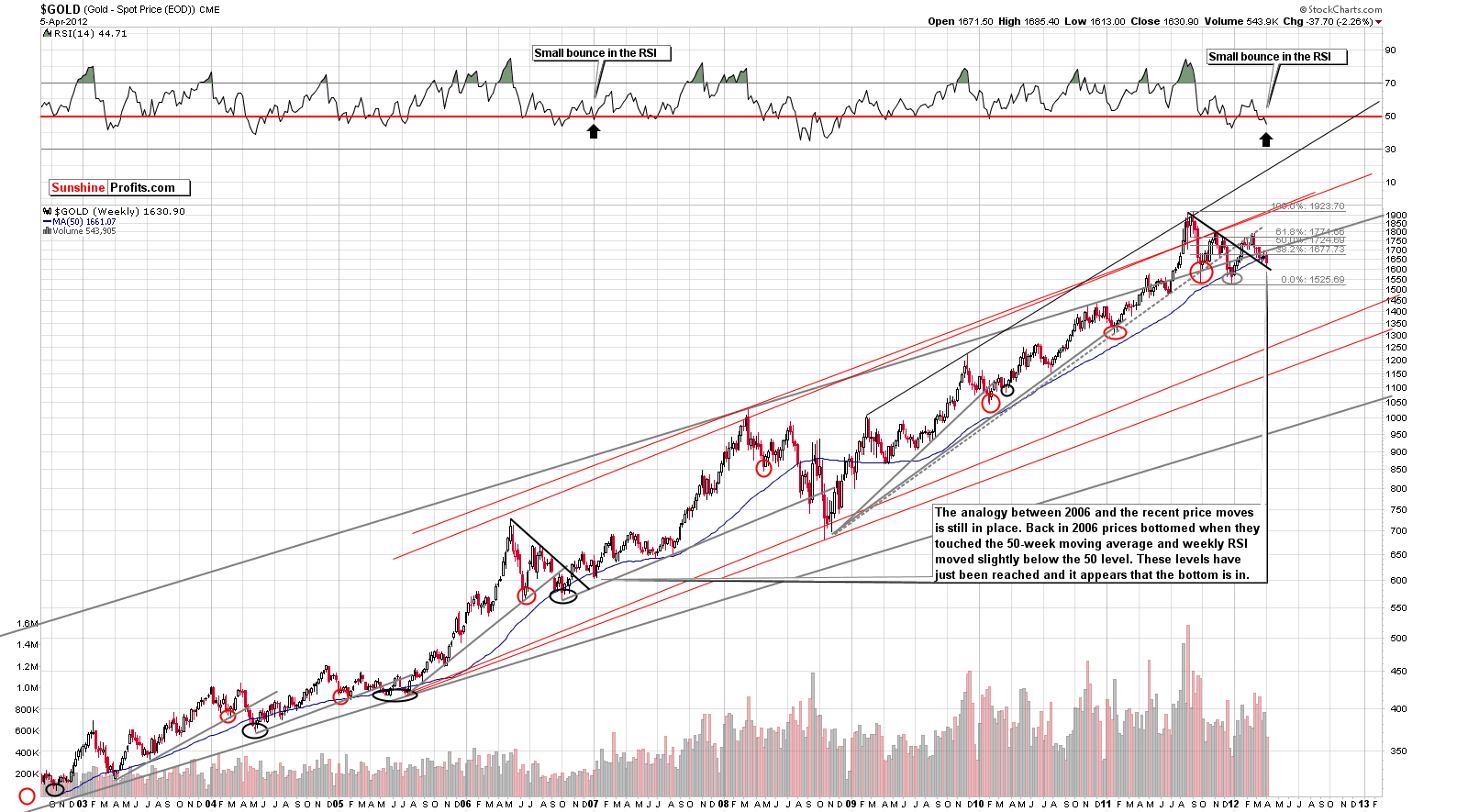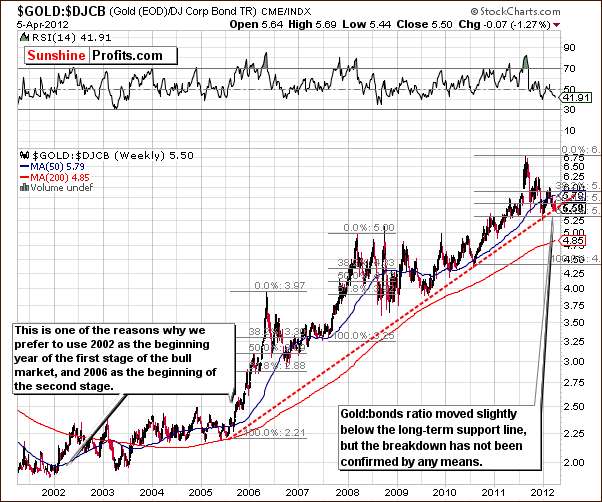Visit our archives for more gold & silver articles.
We often get fearful queries from short-term traders who are concerned about short-term movements in the precious metals market. Now we’re even getting worried e-mails and questions from investors who are holding long-term positions. This is an indication that sentiment is scraping the bottom and that is usually seen at major bottoms.
It is certainly possible that the Fed is really lulled by recent improvements in some economic indicators into thinking that the economic picture is getting rosy, or it could be the case that they just want people to believe that they think so. Anyway, we don’t see it that way. Economic slowdown in Europe, China, India, Latin America and virtually everywhere else is sure to cut demand for American exports. Petroleum and gasoline prices are putting pressure on consumers and cutting into purchases of other goods and services. Saber rattling in the Middle East could make the prices of oil go through the roof. In addition, let’s not forget the eurozone problems that seem to be off the radar, the depressed housing sector, the heavy debt burden that should be keeping government economists awake at night. The Fed would be thrilled to see a weaker dollar and a higher inflation rate that would reduce the real value of the U.S. debt mountain.
Without a doubt, a strike against Iran’s nuclear sites by Israel and or the U.S. would have deep implications for the world’s economy and, for the price of precious metals. But what are the chances that this will take place in the short term?
One member of our team is based in Israel and says most Israelis believe that Israel will not strike on its own. By threatening to strike, Israel successfully places Iran’s nuclear program at the top of the world’s agenda and encourages diplomatic and economic sanctions that could make Iran back off. Perhaps with some luck, the Iranians will overthrow their regime. It’s not that Israel is not taking Iran’s threats seriously. Israeli leaders have learned through history’s most painful lesson that the words of mad tyrants who hold power need to be taken at their face value. Israel is not sitting idly by. In a press conference last week summing up three years in office, Israeli Prime Minister Benjamin Netanyahu said that international sanctions were hurting Iran's economy but not enough to persuade it to curb its nuclear ambitions even slightly. Is this just more saber rattling? A recent Israeli report concluded that reprisals by Iran’s allies from Lebanon and Gaza with rockets launched at Tel Aviv would result in some 300 dead. A nuclear weapon in the hands of the ayatollahs could be more dangerous by far. Another danger is that a nuclear Iran could start an arms race in the Middle East where there are enough unstable regimes to make it intolerably dangerous for the entire world. In any case, it’s unlikely that Israel would do anything before the elections in the U.S. and then depending on who gets elected, Israel might do a joint venture with the Americans. But this is all speculation and all time will tell.
Let’s take a look at what the charts are saying. We will start with the US Dollar Index (charts courtesy by http://stockcharts.com.)

Our first chart is the very long-term USD Index chart. We see that the sideways trading patterns continue between the two levels which are quite important from a technical perspective. These are the declining long-term support line and the horizontal support line based on the early 2011 high. At this point, the very-long term chart remains mixed as the USD Index moved a bit higher once again last week, but no breakout has been confirmed thus far.
Let us now turn to the yellow metal.

We begin our gold section with a look at the very long-term chart (you can click the chart to enlarge it if you’re reading this essay at sunshineprofits.com). Very little has changed last week as gold prices declined slightly and are still (at the moment of creating this essay) above the declining support line. This is very much in tune with the trading patterns seen in 2006, hence the comments made last week and two weeks ago are still appropriate. The shape of the decline is a bit different but the general patterns are still quite similar.
Comparing the RSI levels back then to now is quite interesting. At the end of 2006, the RSI moved a bit higher, then bottomed, and the final bottom was seen for gold prices. In fact, they’ve never moved below the bottom that formed. We had not seen this type of RSI pattern prior to last week, but we have seen it now. So we now have yet another similarity between 2006 and 2012. The consequences are bullish as a strong rally followed back then.

We now turn to the gold:bonds ratio chart which compares daily closing gold prices with corporate bond index. In general, this chart allows us to put all short-term moves into proper perspective. In this case, we see that the ratio moved lower intra-day on Thursday and then reversed to close right at the long-term support line. No breakdown has been seen here, and the situation remains bullish.
Summing up, the rally which followed the cyclical turning point in the USD Index likely contributed to the decline seen in the precious metals sector last week. Since a turnaround appears to be just around the corner for the dollar, the same appears to be the case for the precious metals sector as well.
The outlook for gold remains bullish. Based on closing prices, the long-term support line has been reached. The self-similar pattern discussed for several weeks is still present but somewhat less precise. Other bullish signals have emerged, however, including the shape of the RSI Indicators based on gold’s price. The fact that gold:bonds ratio did not move below its declining support line also supports the bullish case. All indications are that the bottom is now in for gold (or very close to being in) and higher prices will be seen soon.
To make sure that you are notified once the new features are implemented, and get immediate access to my free thoughts on the market, including information not available publicly, we urge you to sign up for our free e-mail list. Sign up for our gold & silver mailing list today and you'll also get free, 7-day access to the Premium Sections on my website, including valuable tools and charts dedicated to serious PM Investors and Speculators. It's free and you may unsubscribe at any time.
Thank you for reading. Have a great weekend and profitable week!
P. Radomski
--
The latest Premium Update is still up-to-date. The situation in the precious metals market is critical, so we've taken extraordinary steps to analyze it even deeper than usually. We introduced 2 additional big, detailed charts featuring GLD (in addition to the one seen in today's free commentary) and HUI and we believe that especially the latter provides very important insight.
Of course, we covered much more things than "just" gold and gold stocks. Among other things, we comment on the current situation in the USD Index (which once again bottomed at the cyclical turning point), stock market, the financial sector, precious metals correlations, gold:bonds ratio, gold from a non-USD perspective, gold from yen perspective (the same chart that helped us detect top at the end of February), silver formations, XAU Index, GDX:SPY ratio, gold miners bullish percent index, and more.
In the latest issue of our Premium Update we discuss selling in May and going away, the possibility that the consolidation will continue, investors' sentiment, and probabilities that silver will move to new highs this year and in the following years. Additionally, we feature one tool that doesn't provide us with signals too often, but it has now - prices of junior mining stocks relative to other stocks.
We encourage you to Subscribe to the Premium Service today and read the full version of this week's analysis right away.

